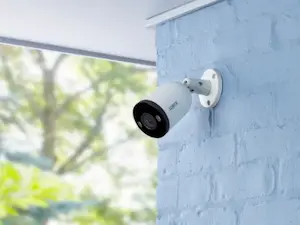Protect Your Property Choose the Best Outdoor Security Camera for Your Business
Posted By Remote Techs On 24-July-2024

Investing in the right outdoor security camera is paramount when safeguarding business premises.
We understand the importance of reliable surveillance systems that provide peace of mind and effective monitoring.
Let’s delve into critical factors when selecting the best outdoor security camera.
By prioritizing these aspects and seeking expert advice from Remote Techs, you can effectively safeguard your property against potential threats and enjoy enhanced peace of mind.
1. Assess Your Surveillance Needs
Assessing your specific surveillance needs is crucial before choosing a security camera. Are you primarily concerned about monitoring the front entrance, large outdoor areas, or both? Understanding your requirements will help determine the type and number of cameras you need.
2. Consider Camera Resolution and Clarity
Resolution is critical to ensuring clear and detailed footage. Today, many outdoor security cameras offer high-definition (HD) or even ultra HD (4K) resolution, capturing sharp images and vital details such as faces or license plates. We recommend cameras with at least 1080p HD resolution for optimal clarity.
3. Opt for Weather-Resistant Cameras
Outdoor security cameras must withstand various weather conditions to maintain reliability. Look for cameras with an IP65 or higher weatherproof rating, indicating resistance to dust, rain, and extreme temperatures. This ensures year-round functionality and durability, which is essential for outdoor use.
4. Choose Between Wired and Wireless Cameras
Both wired and wireless outdoor cameras have their advantages. Wired cameras typically provide a more stable connection and constant power supply, making them ideal for long-term surveillance. On the other hand, wireless cameras offer installation flexibility and are easier to relocate if needed.
5. Night Vision Capabilities
Effective surveillance doesn’t stop when the sun sets. Ensure your outdoor security camera includes infrared night vision technology to capture clear footage in low-light or complete darkness. Look for cameras with a sufficient night vision range suitable for your property size.
6. Evaluate Storage Options
Decide how you want to store and access recorded footage. Many outdoor cameras offer local storage options such as microSD cards or network-attached storage (NAS), providing convenient access to recordings without monthly fees. Alternatively, cloud storage offers remote access and backup, ensuring footage remains secure even if the camera is damaged or stolen.
7. Consider Smart Features and Integration
Modern outdoor security cameras often have advanced features such as motion detection, two-way audio, and smartphone integration. These intelligent capabilities allow real-time alerts, remote monitoring, and communication with visitors or intruders.
8. Review Installation Requirements
Before purchasing, assess the outdoor security camera’s installation requirements. Some models, particularly wired systems or those integrated with existing security systems, may require professional installation. Ensure you have the necessary tools and expertise, or opt for professional installation services for a seamless setup process.
9. Budget Considerations
While investing in quality outdoor security cameras is crucial for property protection, setting a realistic budget is essential. Determine your budget based on the number of cameras needed and desired features without compromising critical security. We offer a range of options to suit various budgets and requirements.
10. Seek Expert Guidance
Given the many options available, choosing the best outdoor security camera can be overwhelming. We, our experts are here to assist you in selecting the right camera tailored to your specific needs and budget. We provide comprehensive guidance, ensuring you make informed decisions that enhance your property’s security.
Selecting the best outdoor security camera for your business involves carefully considering factors such as resolution, weather resistance, storage options, and intelligent features.